Related Research Articles
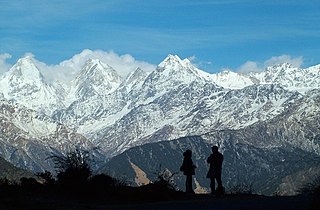
Kumaon is a revenue and administrative division in the Indian State of Uttarakhand. It spans over the eastern half of the state and is bounded on the north by Tibet, on the east by Nepal, on the south by the state of Uttar Pradesh, and on the west by Garhwal. Kumaon comprises six districts of the state: Almora, Bageshwar, Champawat, Nainital, Pithoragarh and Udham Singh Nagar.
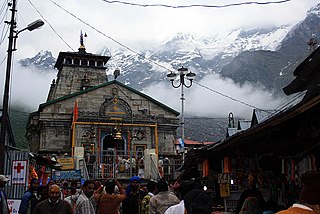
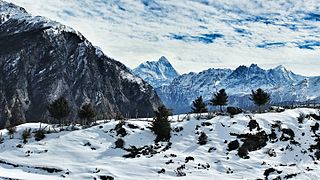
Uttarakhand, also known as Uttaranchal, is a state in northern India. It is often referred to as the "Devbhumi" due to its religious significance and numerous Hindu temples and pilgrimage centres found throughout the state. Uttarakhand is known for the natural environment of the Himalayas, the Bhabar and the Terai regions. It borders the Tibet Autonomous Region of China to the north; the Sudurpashchim Province of Nepal to the east; the Indian states of Uttar Pradesh to the south and Himachal Pradesh to the west and north-west. The state is divided into two divisions, Garhwal and Kumaon, with a total of 13 districts. The winter capital of Uttarakhand is Dehradun, the largest city of the state, which is a rail head. Gairsain, a town in Chamoli district, is the summer capital of Uttarakhand declared on 5 March 2020. The High Court of the state is located in Nainital, but is to be moved to Haldwani in future.
The Panwar dynasty ruled the Garhwal Kingdom. The dynasty independently ruled Garhwal from the ninth to nineteenth century until the Kingdom of Nepal attacked the Kumaon Kingdom in 1791 and Garhwal in 1804. With the help of the British troops, Garhwal and Kumaon gained independence from Nepal. Unable to pay the military cost of British-ruled India, the then-Garhwali king gave part of his territory to the Raj and ruled until 1949. The last king of Garhwal, Manabendra Shah, decided to join India after it became independent. Garhwal and Kumaon became part of India as the then-state of Uttar Pradesh, which is now Uttarakhand. Pt. Harikrishna Raturi king Bhanu Pratap was the first ruler of Panwar dynasty in Garhwal who founded Chandpur-Garhi as his capital. This was is strongest Garh for the fifty-two Garhs of Garhwal.

The Chand kings were a Hindu Rajput ruling clan of Kumaon Kingdom. The Chand kingdom was established by displacing the Katyuri kings by Som Chand,a prince from Jhushi. They ruled until before they were defeated by the Gorkha Kingdom in 1790 CE. The Chand kings ruled over the Kumaon Kingdom and parts of the Farwestern Nepal called Doti in present day Sudurpashchim Province.

Tehri Garhwal is a district in the hill state of Uttarakhand, India. Its administrative headquarters is at New Tehri. The district has a population of 618, 931, a 2.35% increase over the previous decade. It is surrounded by Rudraprayag District in the east, Dehradun District in the west, Uttarkashi District in the north, and Pauri Garhwal District in the south. Tehri Garhwal is a part of the Himalayas.

Uttarkashi District is a district of Garhwal division of the Uttarakhand state in northern India, and has its headquarters at Uttarkashi city. It has six Tehsils namely Barkot, Dunda, Bhatwadi, Chinyalisaur, Purola and Mori.

Almora is a municipal board and a cantonment town in the state of Uttarakhand, India. It is the administrative headquarters of Almora district. Almora is located on a ridge at the southern edge of the Kumaon Hills of the Himalaya range. The Koshi (Kaushiki) and Suyal (Salmale) rivers flow along the city and snow-capped Himalayas can be seen in the background.

Baijnath is a small town on the banks of the Gomati river in the Bageshwar district in Kumaon division of Uttarakhand, India. The place is most noted for its ancient temples, which have been recognized as Monuments of National Importance by the Archaeological Survey of India in Uttarakhand. Baijnath has been selected as one of the four places to be connected by the 'Shiva Heritage Circuit' in Kumaon, under the Swadesh Darshan Scheme of the Government of India.
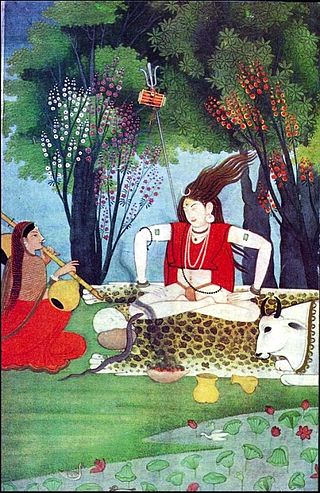
Mola Ram or Maula Ram (1743–1833) was an Indian painter, who originated the Garhwal branch of the Kangra school of painting. He was also a poet, historian and diplomat. Much research about him was done by Mukandi Lal.
Fateh Shah was the Hindu Rajput king of Garhwal, a small kingdom in North India, from 1684 to 1716.

Dehradun is the capital of The Indian state of Uttarakhand, and has a rich and eventful history, it also finds mention in scriptures as well.
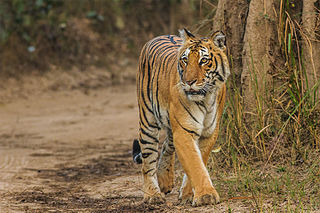
Uttarakhand is a state in North India. Its name, which means "northern land" or "section" or "northern part" in Sanskrit, is mentioned in early Hindu texts as the combined region of Kedarkhand and Manaskhand.

The Garhwali people are an Indian ethnolinguistic group native to the Garhwal, in the Indian state of Uttarakhand, who speak Garhwali, an Indo-Aryan language.

Garhwal Kingdom was an independent Himalayan kingdom in the current north-western Himalayan state of Uttarakhand, India, founded in 688 CE by Kanak Pal, the progenitor of the Panwar dynasty that ruled over the kingdom uninterrupted until 1803 CE.

Kumaon Kingdom was an independent Himalayan kingdom in Kumaon, a region located in the eastern part of the present-day Uttarakhand state of India. It was established around 7th century and remained an independent and sovereign kingdom until 1791.
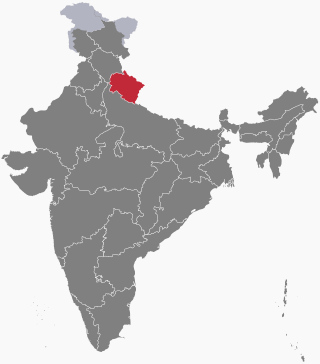
The following outline is provided as an overview of and topical guide to Uttarakhand:
Battle of Khurbura or Battle of Khudbuda also known as Gorkha-Garhwal War occurred in May 1804 near modern-day village of Dehradun, Khurbura 30.3256°N 78.0267°E. The battle is regarded as the first major attack in the history of Garhwal Kingdom that triggered between Kingdom of Nepal forces and Maharaja Pradyumna Shah, and continued for 13 days until the Garhwal king was defeated. It is chiefly regarded the only defeat of Pradyumna Shah's life and the victory of Gorkhali forces under Kingdom of Nepal.

Sudarshan Shah, also known as Raja Sudarshan Shah of Garhwal Kingdom, was the ruler and the founder of modern-day New Tehri city of Tehri district. He reigned the kingdom between 1804 and 1859. British army aided the king to reign the territory after royal army defeated Gorkha forces during the Battle of Khurbura.

Aipan is an established-ritualistic folk art originating from Kumaon in the Indian Himalayas. The art is done mainly during special occasions, household ceremonies and rituals. Practitioners believe that it invokes a divine power which brings about good fortune and deters evil. The art is special as it is done on empty walls, which are brick-red in color, called Geru. The actual art is done with a white paste made of rice flour. The art is frequent to floors and walls of Puja rooms and entrances of homes. It is also practiced mostly by Kumaoni women. The art form has great social, cultural and religious importance.
References
- ↑ Rawat, Ajay S. (11 November 2002). Garhwal Himalayas: A Study in Historical Perspective. Indus Publishing. ISBN 9788173871368 – via Google Books.
- ↑ "Memorial of 54th Garhwal king in Dehradun lying desolate, forgotten | Dehradun News - Times of India". The Times of India. 31 December 2018.
- ↑ Service, Tribune News. "King Pradyumna 'deserves' a memorial". Tribuneindia News Service.
- ↑ Strahorn, Eric A., 1965-. An environmental history of postcolonial North India : the Himalayan Tarai in Uttar Pradesh and Uttaranchal (eBook, 2009) [WorldCat.org]. OCLC 839827279 . Retrieved 17 September 2021– via WorldCat.org.
{{cite book}}: CS1 maint: multiple names: authors list (link) - ↑ "Historical Background | Uttarakhand Open University". uou.ac.in. Archived from the original on 14 June 2013. Retrieved 11 February 2020.
- ↑ KAFALTIA, HIMANSHU KAFALTIA, GUNJAN SHARMA (18 September 2019). A Comprehensive Study of UTTARAKHAND. Notion Press. ISBN 9781646506057 – via Google Books.
{{cite book}}: CS1 maint: multiple names: authors list (link) - ↑ "History | District Tehri Garhwal, Government of Uttarakhand | India".
- ↑ http://censusindia.gov.in/2011census/dchb/0506_PART_B_DCHB_GARHWAL.pdf [ bare URL PDF ]
- ↑ "VIDEO: गढ़वाल रियासत के वीर योद्धा का समाधि स्थल बदहाल". Hindustan Dainik.